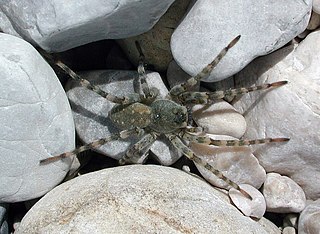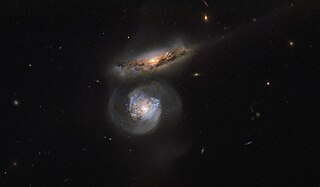
Arctosa cinerea is one of the most conspicuous wolf spider of central Europe, with a palearctic distribution and also found in Congo. The spider reaches a length of 17 mm, and occurs only on sandy beaches of rivers, lakes and oceans. Its grey-brown color makes for a good camouflage, and so it is not often seen, even if it wanders around during daylight. They dig holes in the ground, which they cover with silk, or hide under rocks.

Arctosa is a genus of wolf spiders first described by Carl Ludwig Koch in 1847. As of February 2019 it contains 169 species.
Arctosa alpigena is a wolf spider species in the genus Arctosa with a holarctic distribution.
Arctosa is a wolf spider species found in Europe and Russia.
Arctosa fulvolineata is a wolf spider species in the genus Arctosa found in Europe, Mallorca and North Africa.
Arctosa tbilisiensis is a wolf spider species in the genus Arctosa found in Europe.
Arctosa similis is a wolf spider species in the genus Arctosa found in Canary Islands, Morocco, Portugal to Croatia.
Arctosa stigmosa is a wolf spider species found in Europe and Iran.
Arctosa excellens is a wolf spider species found in Portugal and Spain.

NGC 5765, also designated as MCG+01-38-004 and MCG+01-38-005, is a pair of interacting megamasers in the constellation Virgo, roughly 400,000,000 light-years (120,000,000 pc) away from Earth. NGC 5765B is active, and energy is released from the core, some of which is absorbed by a nearby cloud of water. The cloud then re-emits this energy as microwaves. These emissions were used to help redefine the Hubble constant.

NGC 4531 is a spiral galaxy located about 50 million light-years away in the constellation Virgo. It was discovered by astronomer William Herschel on April 17, 1784. NGC 4531 is member of the Virgo Cluster.

NGC 4528 is a barred lenticular galaxy located about 50 million light-years away in the constellation Virgo. It was discovered by astronomer William Herschel on March 15, 1784. The galaxy is member of the Virgo Cluster.

Arctosa raptor is a species of wolf spiders in the family Lycosidae. It is found in Russia, Nepal, the USA, and Canada.
Arctosa emertoni is a species of wolf spiders in the family Lycosidae. It is found in the USA and Canada.

Arctosa littoralis, the beach wolf spider, is a species of wolf spider in the family Lycosidae. It is found in North and Central America.

NGC 4607 is an edge-on spiral galaxy located about 56 million light-years away in the constellation Virgo. NGC 4607 was discovered by astronomer R. J. Mitchell on April 24, 1854. The galaxy is a member of the Virgo Cluster.

Arctosa rubicunda is a species of wolf spider in the family Lycosidae. It is found in the USA and Canada.
Arctosa sanctaerosae, the Santa Rosa wolf spider, is a species of wolf spider in the family Lycosidae. It is found in the United States.

Arctosa perita is a species of wolf spider in the family Lycosidae. It is found in Europe, North Africa, Turkey, Caucasus, Russia, and has been introduced into Canada.

Arctosa leopardus is a species of spiders belonging to the family Lycosidae.









